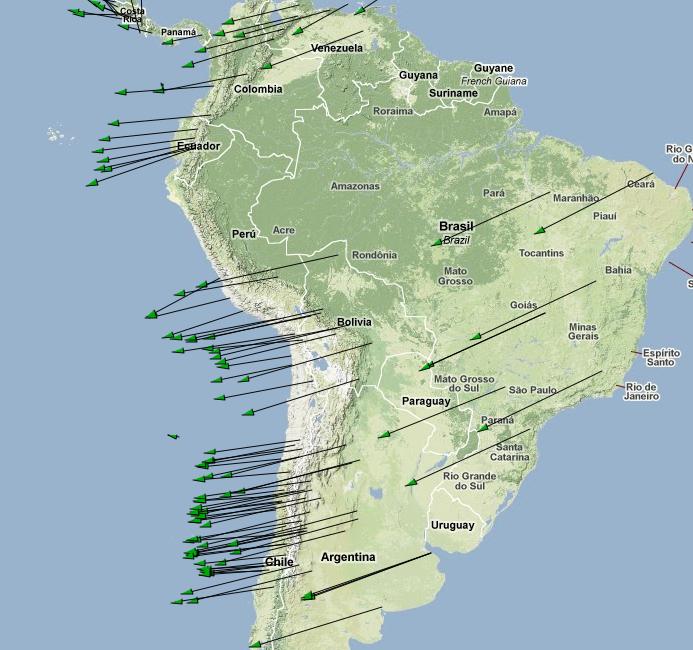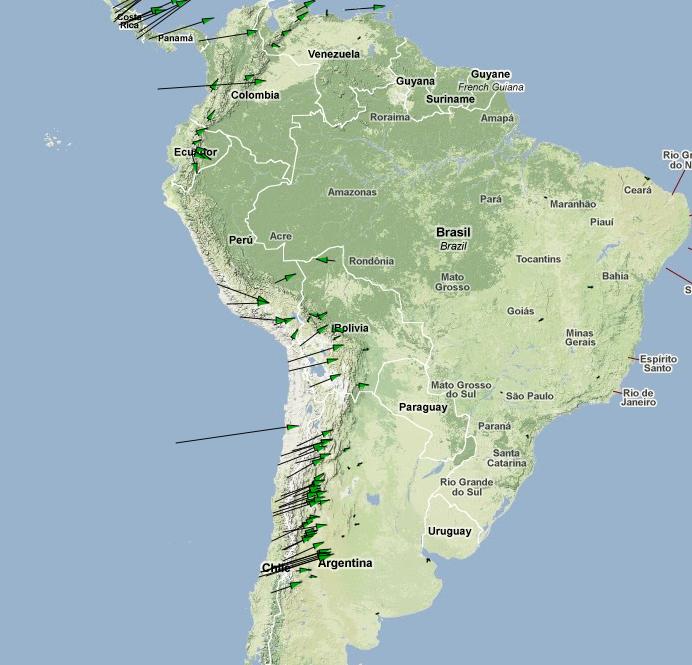GPS Velocities Reference Frames
Map Viewer: GPS Velocities, Earth's Tectonic Plates, Earthquakes, and Volcanoes
Here we explain the concept of Reference Frames, as used in the GPS Velocity Viewer.
Plate Tectonics and GPS 'Reference Frames'
The surface of the Earth is not stationary. It moves. Different places on the Earth are moving in different directions and speeds. The speed is very slow - usually slower than your fingernails grow - but these motions make mountains and cause earthquakes. Over millions of years continents move thousands of miles and push up mountain ranges like the Alps. GPS velocity vectors show precisely how the surface of the Earth is moving today.
But you have to ask, moving as compared to what? Since every location on the Earth is moving, how do you say how fast something is moving? You can only compare how fast one place is moving compared to another place.
Scientists use a short list of certain regions on the Earth as standard places to compare to; these are called 'reference frames.' Usually there is one reference frame for each tectonic plate. For example you might wonder how the Pacific plate is moving past North America, and use North America as the reference frame.
A 'reference frame' is a point of view. If your reference frame is North America, you are standing on North America, seeing how other places move, from your point of view.
Network of the Americas (NOTA) GPS derived data products for GPS station coordinates are available for two reference frames: the North American tectonic plate (NAM14) and a global reference frame (IGS14). NAM14 assumes that the interior eastern part of North America functions as a 'stable' rigid plate and deformation at the plate boundaries (particularly apparent that the western boundary) is shown in relation to the stable part of the plate. IGS14 is a 'no net rotation' reference frame. 'No-net-rotation' (NNR) is the motion of each plate with respect to the weighted average of all of the world's plate velocities. It is sometimes referred to as absolute plate motion, since it appears to approximately represent the motions of the surface plates with respect to the Earth's deep interior. It closely resembles the apparent motion of the world's plates with respect to hot spot volcanoes. IGS14 is based on the International Terrestrial Reference Frame (ITRF).
The GEM Strain Rate Map Project provides a choice of several reference frames for their collection of thousands of velocity vectors from around the globe, and a 'no net rotation' reference frame.
The GAGE GPS Velocity Viewer allows users to view GPS vectors from around the world in a range of reference frames including the global IGS08 and many regional reference frames. For example, the screen shots below from the Velocity Viewer show GPS velocity vectors in South America for two different reference frames.

Plot of South American GPS stations' motions compared to the Nazca plate reference frame. The Nazca plate is just west of South America.

Plot of South American stations' motions with South American plate reference frame. The South American reference frame assumes that central and eastern South America move as a stable unit. Why are stations along the west edge of South America moving towards the interior?
For more about plate tectonics
Maps of the Earth's Tectonic Plates:
Descriptions of the Earth's tectonic plates:
- Plate Tectonics & Our National Parks (National Park Service)
- MORVEL: A Precise Model Of Tectonic-Plate Movements
- Understanding Plate Motions (US Geological Survey)
- Plate Tectonics: Windows to the Universe (UCAR)
- This Dynamic Planet plate viewer tool (Smithsonian Institution).
- GPS - Measuring Plate Motion: How fast are the tectonic plates moving? (IRIS)
Other GAGE presentations and tutorials:
- Analyzing Plate Motion Using EarthScope GPS Data
- Measuring plate motion with GPS
- More resources are available on GAGE's Educational Resources page
Last modified: 2024-06-05 15:42:33 America/Denver
)